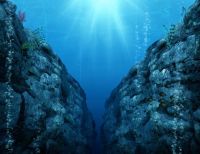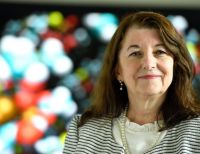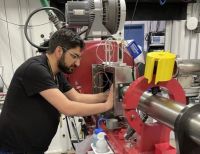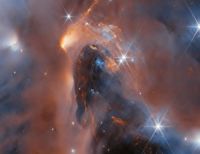By the time the $9.7 billion James Webb Space Telescope launches from French Guiana in December and soars toward space 1 million miles from Earth, it will have been 60 years since James Webb took over the helm of the National Aeronautics and Space Administration, 17 years since construction of the telescope began, and three years since NASA—delayed by technical issues and the coronavirus pandemic—planned to put the instrument into action.
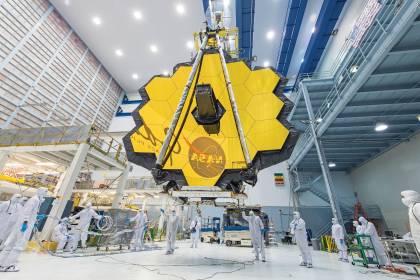
Worth the wait? A gaggle of scientists, including a host of Johns Hopkins astronomers and physicists directly involved with the project, thinks so.
With its 21-foot segmented primary mirror designed to see galaxies 13 billion light-years away, along with a tennis court–size sunshield that acts as a parasol to protect the craft's precision instrumentation from heat, Webb will complement the 31-year-old Hubble Space Telescope. Webb's mirror array will operate at about 100 times the sensitivity of Hubble's as it explores the universe's first light, the birth of stars, and the origins of life. In essence, Webb will cover a scientific blind spot, the light too old, too faint, and too distant for Hubble to observe.
After all this time, it's hard for NASA, which is teaming up with the European Space Agency and the Canadian Space Agency on the project, to hold back its enthusiasm. Webb, it declares, is "the largest, most powerful, and most complex space telescope ever built and launched into space. It will fundamentally alter our understanding of the universe."
See back in time? Yes. Capture images we've never been able to see, like the first galaxies forming after the big bang? Yes. Webb will offer unprecedented views of the heavens far surpassing any available with current telescopes, including incredibly detailed views of nebulas and star systems in the distant universe.
"Hubble has become an icon. It has rewritten textbooks. It's changed our society's—our world's—perspective on the universe around us," says William Blair, an astrophysicist and research professor in the Department of Physics and Astronomy at Johns Hopkins and the user support project scientist for Webb. "But Webb is looking at things in a different way. And every time we look at things in a different way, we learn new and fascinating things about the universe around us."
Blair, who has been involved with the project since its early days, realizes some might raise an eyebrow at Webb's price tag and long gestation. But for an astronomer who grew up fascinated by the night sky that he first inspected with the 4-inch telescope his parents bought him, Blair says that Webb represents a key to answers eternal.
"Our product is inspiration and education," he says, "but ultimately, it's the knowledge that we learn about the universe that will be world changing. And it's hard to put a price tag on that."
The scientific marvel that is the Webb telescope is named for a nonscientist.
James Webb was a World War II Marine pilot, lawyer, executive in the oil and gyroscope businesses, congressional staff member, and President Harry Truman's budget director. In 1916, barely two years after NASA opened for business, he became the agency's second administrator. (The first was T. Keith Glennan.) Webb led the Apollo Project effort to meet President John F. Kennedy's goal of landing a man on the moon before the end of the decade. Apollo astronaut Neil Armstrong would do so on July 20, 1969, nine months after Webb had announced his resignation as administrator.
By then, the first plans for a space telescope were already under way.
As early as 1965, Webb had declared a major space telescope as a top NASA priority, and by 1969 the National Academy of Sciences supported what was then simply dubbed a "Large Space Telescope" orbiting Earth, or perhaps one installed on the surface of the moon that would, in their words, "make a dominant contribution to our knowledge of cosmology—to our understanding of the content, structure, scale, and evolution of the universe." All of this, even though Webb himself didn't fathom the science needed to make this a reality.
"I don't know that he had any vision from the standpoint of the telescope beyond what any intelligent person would have," said W. Henry Lambright, author of Powering Apollo: James E. Webb of NASA, published by Johns Hopkins University Press in 1995. "He did listen to scientists, but I don't think he personally had a vision for the cosmos. Webb was always looking ahead from the standpoint of NASA and what it could do in the future. It was clear to him that it would be important to demonstrate the usefulness of the capabilities that NASA was developing in the '60s, and one of the ways you could do that would be to show how useful you were to science, and a space telescope clearly would be very important for science."
Webb's knack for navigating Washington was crucial to paving the way for the telescope, says Lambright, a professor of public administration and international affairs and political science at Syracuse University.
"He was good with the politics of an organization but also good with the politics external to the organization—the Congress, the president, the public," Lambright says. "He would think about what would make NASA appeal to many audiences. What do I have to do to make NASA survive beyond Apollo? He thought like what he was, which was a very astute government executive."
NASA would have to be dedicated to science, not just to transporting astronauts into space.
"That's why the telescope is named after him—because enough people who know something about the early '60s understood that if the decision-making process had gone a different way, the science of NASA might have been crushed fairly early on," Lambright adds. "A lot of scientists don't appreciate how easily a lot of the money that they got in the '60s would have evaporated without Webb because the dynamics were for going to the moon and beating the Russians."
What the telescope has become might far outstrip any hopes Webb—or even scientists back in NASA's early days—might have had of it. But, first, came Hubble.
A year before Hubble was set to launch, scientists were already envisioning its successor. In September 1989, NASA and the Space Telescope Science Institute, located on the Johns Hopkins Homewood campus and operated by the Association of Universities for Research in Astronomy, co-hosted the Next Generation Space Telescope Workshop. More than 130 astronomers and engineers proposed that NASA investigate the feasibility of a telescope in a high-Earth orbit (26,000 miles or beyond) or one based on the moon. The goal was to study the earliest star and galaxy formation in the universe by being able to observe what's called high redshift. Since the universe is expanding, light from the early universe stretched because the fabric of space-time has stretched. As these distant objects move farther away from us, the light we see is lengthened to longer wavelengths with a corresponding decrease in its photon energy, a phenomenon known as redshift.
The school bus–size, solar-powered Hubble, launched into space by the space shuttle Discovery on April 24, 1990, is in a close orbit around Earth, about 340 miles above it. The more than 1 million observations it has made have helped scientists estimate the age (almost 14 billion years) and size of the universe and helped us better understand how planets and galaxies form. Hubble's instruments work mainly in the ultraviolet and visible parts of the spectrum but can observe a small portion of the infrared spectrum.
NASA calls Webb the scientific successor to Hubble because it builds on what has been learned from that telescope, which stopped its observations for a month in mid-2021 until computer problems could be repaired. Hubble will continue to operate for years, NASA says, but such technical problems have led to questions about how much life it has left.
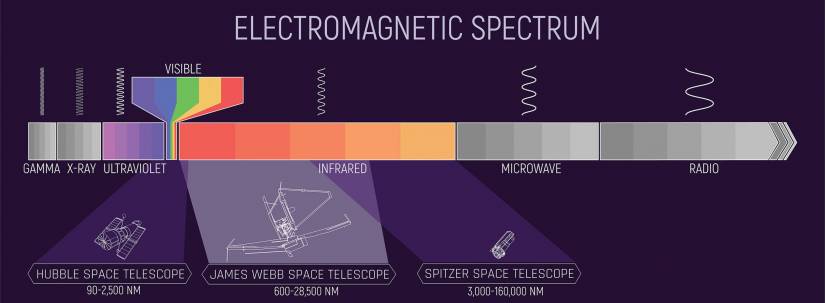
Blair was a member of the instrument definition team for the Faint Object Spectrograph, an original instrument on Hubble that spread out the light gathered by the telescope so that the chemical composition, temperature, and other properties of celestial objects could be determined. Blair was inspired to go into his field by the Mercury, Gemini, and Apollo programs of the 1960s and has worked on telescopes and satellites for decades, including the Hopkins Ultraviolet Telescope developed to make astronomical observations in the far-ultraviolet portion of the electromagnetic spectrum, where wavelengths of light exist that can't be seen by ground-based telescopes.
"Hubble works in optical light that our eyes are sensitive to and actually extends down into the ultraviolet light spectrum and a little bit into the infrared spectrum at the red end of the optical spectrum. But the sensitivity then cuts off just a little ways outside the red end," Blair explains. "It turns out that infrared light, which is farther out the red end of the spectrum than where Hubble can see, has become a very interesting area, scientifically, because of how much more it can reveal."
The colors of the visible light spectrum are the rainbow of red, orange, yellow, green, blue, indigo, and violet, placed in order of the wavelengths starting with red (the longest) and ending with violet (the shortest). Beneath violet is ultraviolet, while beyond red is infrared.
Stars and planets that are just forming lie hidden behind cocoons of dust that absorb visible light. However, infrared light emitted by these regions can penetrate this dusty shroud and reveal what is inside. By covering longer wavelengths of light than Hubble and having greatly improved sensitivity, Webb will be able to look further back in time to see the first galaxies that formed in the early universe, almost 14 billion years ago, and to peer inside dust clouds where stars and planetary systems are forming today.
"Just because our eyes are not sensitive to infrared light doesn't mean it's not light, so you can still have detectors that sense it and can turn that into the data that we use for the science—pictures and spectra where the light is broken up into its component colors," Blair says. "There are just some things that Hubble can't do—because it can't access this part of the light spectrum—but the Webb telescope will."
Webb is designed to be operational for at least five years, with a goal of more than 10 years or until the onboard fuel runs out. During that time, the telescope will do, well, a whole lot of looking around. The list of the project's major goals reads like one colossal history-of-the- universe field trip. Webb will search for the first galaxies or luminous objects formed after the big bang; determine how galaxies evolved from their formation until now; observe the formation of stars from the first stages to the formation of planetary systems; and measure the physical and chemical properties of planetary systems, including our own solar system, and investigate the potential for life in those systems.
William Blair
astrophysicist
"Webb can see edge-of-the-universe stuff, the stuff that's way far back in time."
"Webb can see edge-of-the-universe stuff, the stuff that's way far back in time," Blair says. As NASA describes it, looking out in space is like looking back in time. It sounds magical, but it's actually very simple. Light needs time to travel across the vast distances of space to reach us. Across our Milky Way galaxy, distances are measured in terms of how many years it takes light to travel. The nearest star, Proxima Centauri, is just over four light-years away. So when we look at Proxima Centauri, we see it not as it is today, but as the light that left that star four years ago and is just reaching us now. The same logic applies to some of the universe's oldest and most distant objects.
After being launched on October 31 by an Ariane 5 rocket, a European Space Agency contribution to the mission, Webb will travel for a month to reach its orbit at the second Sun-Earth Lagrange point, some 932,000 miles away. The Space Telescope Science Institute will conduct the science and mission operations for Webb, as it has supported the science operations for the Hubble Space Telescope since its launch.
After reaching its destination, Webb will begin its ambitious, deep-sky survey to trace the formation and evolution of the first galaxies in what is possibly the cosmos's busiest star-forming period. Soon we can start to address questions like how rapidly galaxies form and assemble, and how quickly and where they form their stars. Also, scientists know that supermassive black holes were already in place less than 1 billion years after the big bang, and with Webb they hope to detect the primeval seeds of these galactic monsters.
Given that we have not yet been able to observe when galaxies began to form, it's not known, for example, whether black holes caused the galaxies to form, or vice versa. And Webb's penetrating view may help determine how many planetary systems could be hospitable to life and whether some Earth-like planets have enough water to have oceans.
For Lee Feinberg, Engr '98 (MS), Webb's optical telescope element manager, who works from NASA's Goddard Space Flight Center in Greenbelt, Maryland, Webb represents a pinnacle in human ingenuity and scientific endeavor. For one, scientists and engineers turned Webb into a piece of enormous origami. "We're demonstrating that we can build a segmented telescope and basically unfold it in space and be able to align it and show that it's just as good optically as the Hubble telescope," says Feinberg, who worked for 10 years on Hubble before joining Webb in 2001. "That will really set the stage for the future."
Webb has an unfolding mirror, with segments like the leaves of a drop-leaf table because the mirror is too large to fit on a rocket. In the second, third, and fourth months after launch, the primary segments will be aligned to work as a single mirror, in order to capture clear images.
Making Webb cold is one of the keys to making it see.
"Infrared light is basically heat, so we're looking for heat radiation from objects millions of light-years across space," says Blair, who describes his role with Webb as enabling the connection between the science that people want to do and the instruments needed to do it. "If you want to be sensitive to those very faint heat signals, you have to have a very cold telescope."
That is achieved by unfurling the sunshade.
The telescope had to be developed to work at 40 degrees above absolute zero, even though it's being manufactured and tested here on Earth in relatively normal conditions. "You can imagine the challenges that are involved in putting a telescope like this together," Blair says. "So, it's going to be a pretty nerve-wracking time for roughly the first month after launch, after it's moving out into its orbital position where all these things are unfolding and getting checked out and getting positioned to actually operate the telescope the way it's supposed to operate. Quite a challenge."
Because Hubble's mirrors are made of ultra-low expansion glass kept at a "room temperature" of about 70°F to avoid warping, it is limited in what it can see in the infrared. Astronomers determined that what was needed was an infrared telescope "that's cold—very cold," says Feinberg, whose father, Edward, was in the Air Force program that worked with monkeys in space in the 1960s. To go all the way out into the mid-infrared, Feinberg says, Webb's mirrors needed to go down to about -370° F, and they needed to be really large in order to get both the resolution and sensitivity to see the faintest of light wavelengths.
The understanding right from the beginning was that Webb would be a general-class observatory and support all sorts of science, just as Hubble does.
That openness is part of what excites Julie Van Campen, Engr '07 (MME), Webb's integrated science instrument module systems engineer, about the telescope, which she has worked on since 2003.
"Our telescope is interesting, it's big—it's also general purpose. People from all over the world can make proposals and do research with the telescope," she says. "It's not like this telescope is owned by the university of such-and-such and scientists there make all the decisions on what observations get made. It's more like a public telescope."
Collaborating with teams from overseas to integrate the instruments has been particularly challenging yet fulfilling, according to Van Campen, who is based at Goddard.
"It was just lots and lots of people working together, and it was a lot of fun to learn how people work and build and think. And everything they do is a little different. You learn a lot from them, how they approach design, how they approach documents, how they approach even teamwork is a little different in different cultures," she says. "You think one government agency has a lot of bureaucracy? We're talking three different government agencies—NASA, ESA, CSA, plus all our corporate partners. Talk about bureaucracy. You have to embrace it."
One of the planned observations that NASA only recently detailed is studying Beta Pictoris, a young planetary system with at least two planets and a dusty disk. The goals include gaining a better understanding of the structures and properties of the dust to better interpret what is happening in that system and to help understand whether the contents of our solar system are unique.
"It's going to create a deeper understanding of our universe, how stars and galaxies formed and how we were able to evolve to our current state," says Mark Voyton, Engr '96 (MS), who was inspired to pursue a career in space science in sixth grade while watching a program about Apollo's lunar landing in 1969. For the past two decades, he has designed instruments for observing the planets, the sun, and the stars. "And the deeper understanding we have of the past will certainly enhance and create a much deeper understanding of what can be expected in the future."
Even the hope of discovering new life forms.
"One of the things that has come about during the lifetime of the design and development of the James Webb Space Telescope has been the notion that we will possibly find planets in other star systems and possibly get a deeper understanding of other lifelike entities that coexist with us in the universe," says Voyton, who has worked on Webb since 2002, leading the design and development of the data systems for the instrument modules.
Voyton, who also works from Goddard, has received NASA's Outstanding Leadership Medal and its Robert H. Goddard Honor Award for exceptional achievement in engineering and management. He cites his biggest achievement on Webb as leading the team that took the telescope through testing at Johnson Space Center. "The most rewarding moments were when we were able to put synthesized light through the whole optics chain and to be able to know that the telescope and the optics were going to perform as expected," he says. "That was probably the most significant and rewarding part of my career."
As the integrated science instrument module manager and the optical telescope and ISIM manager for Webb, he will be the launch site manager in French Guiana—chosen for its proximity to the equator, on the northeastern coast of South America, as the spin of Earth can help give an additional push. Launching from the equator makes the spacecraft move almost 500 km/hour faster once it is launched.
"Webb represents the desire and capability of humans to build tools that are extraordinarily difficult to realize, but they undertake such projects to go after an understanding that would otherwise not be achievable," Voyton says.
Development of Webb began in 1999; initially, expected launch dates ranged from 2007 to 2011. In 2011, the House Appropriations Committee, after a review concluded that NASA's launch and cost estimates were unachievable, recommended canceling Webb. But it was saved after NASA revised the project, including streamlining its oversight within the agency. Technical issues and the pandemic led to more delays.
Despite the barriers, the scientists—some of whom have been working on the project for decades—are determined to see it through.
"Even though it seems like there are delays in this, we're always moving forward," Van Campen says. "It never stops moving. And each phase that we go through is so completely different from what we did a year ago. Each piece of it is so different from the last. It always is interesting."
Feinberg says seeing Webb through launch is almost like a duty.
"There is an element of feeling like I would be remiss in not finishing it," he says. "There's so many people who have worked on this. I kind of owe it to them to do everything possible to make it successful."
Tom Kertscher is a Milwaukee-based freelance writer.
Posted in Science+Technology
Tagged astronomy, hubble, telescopes, webb










